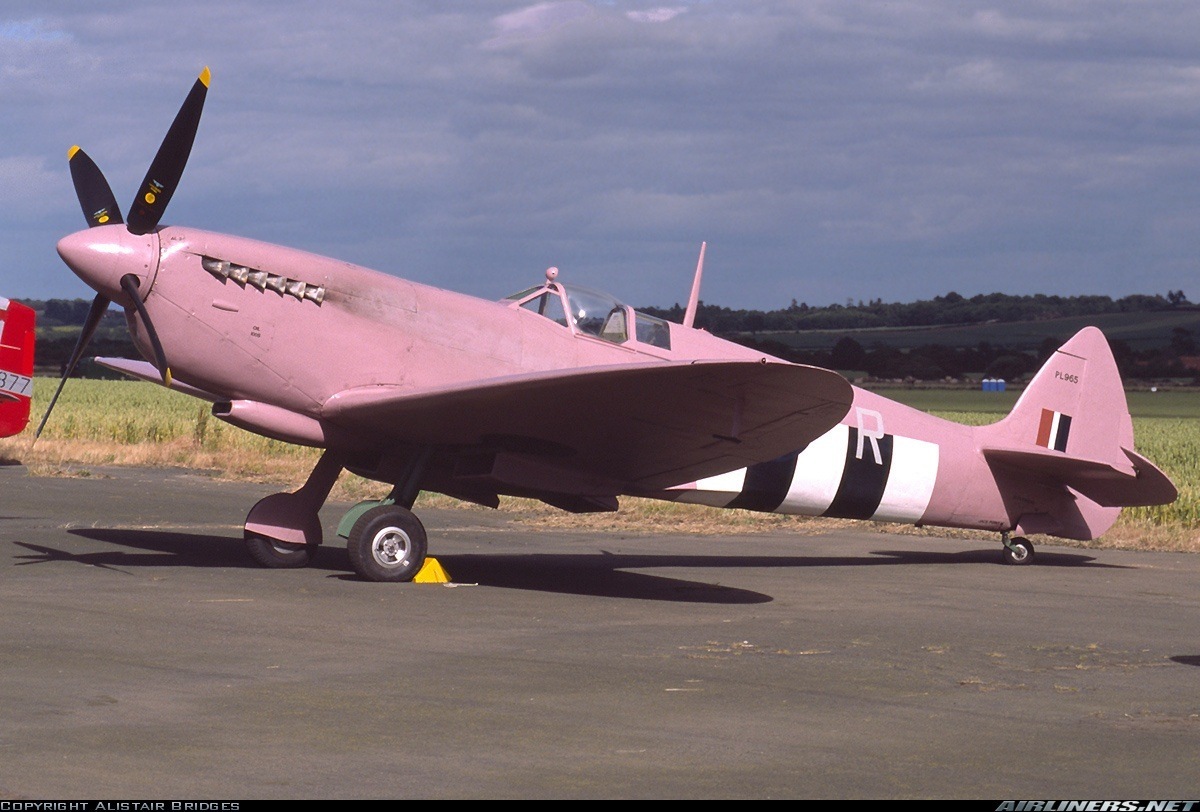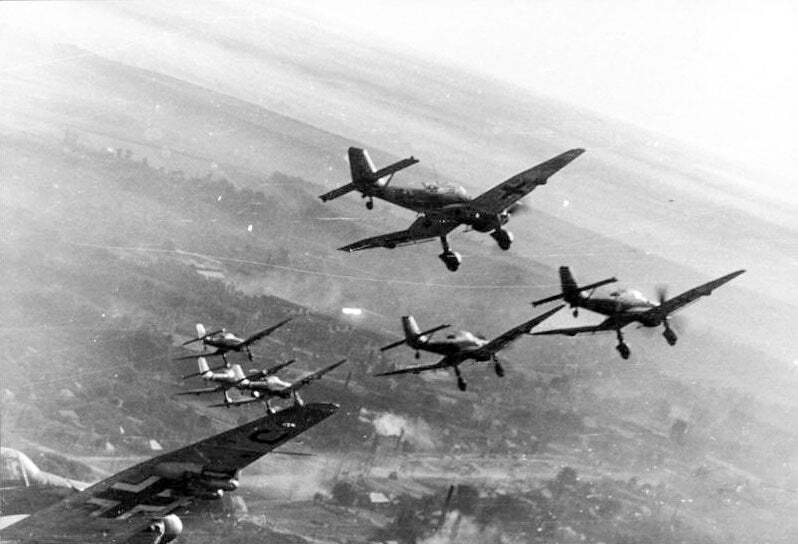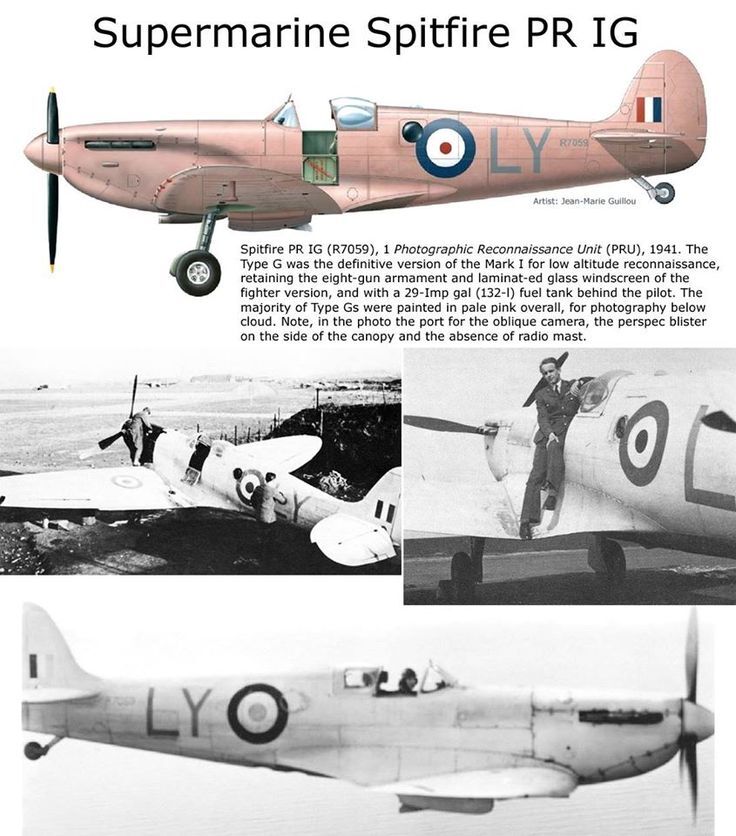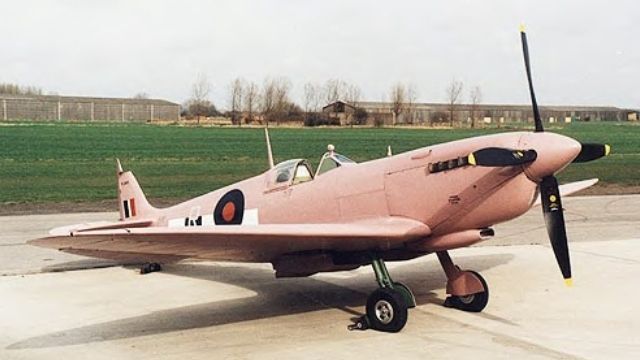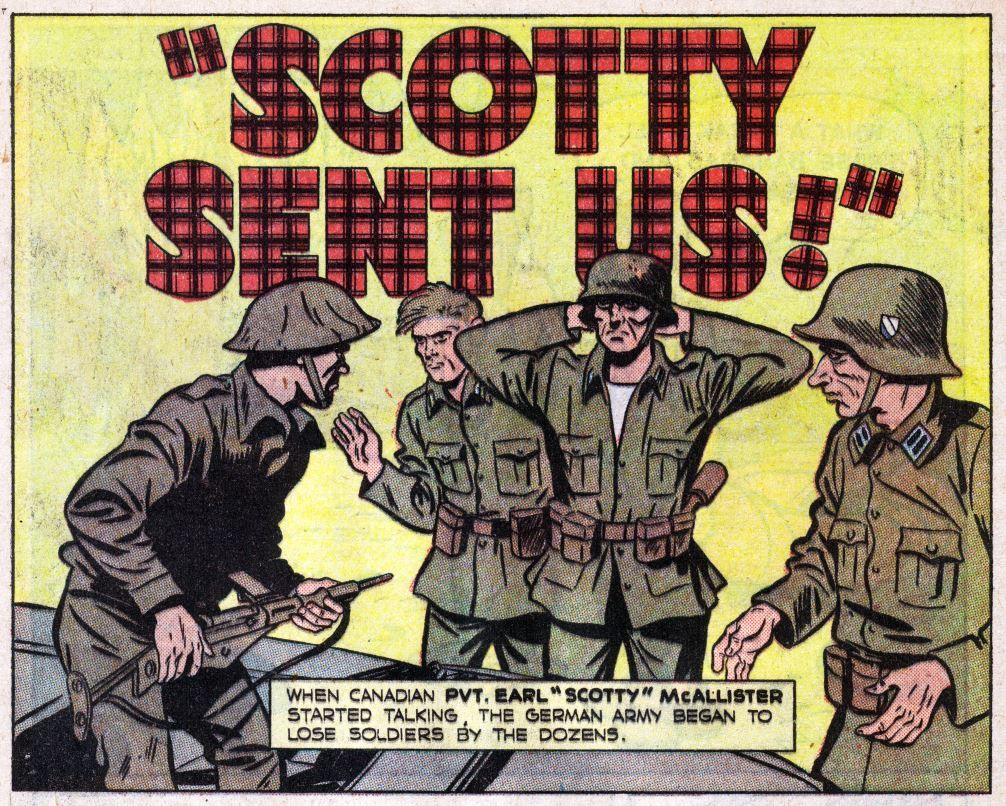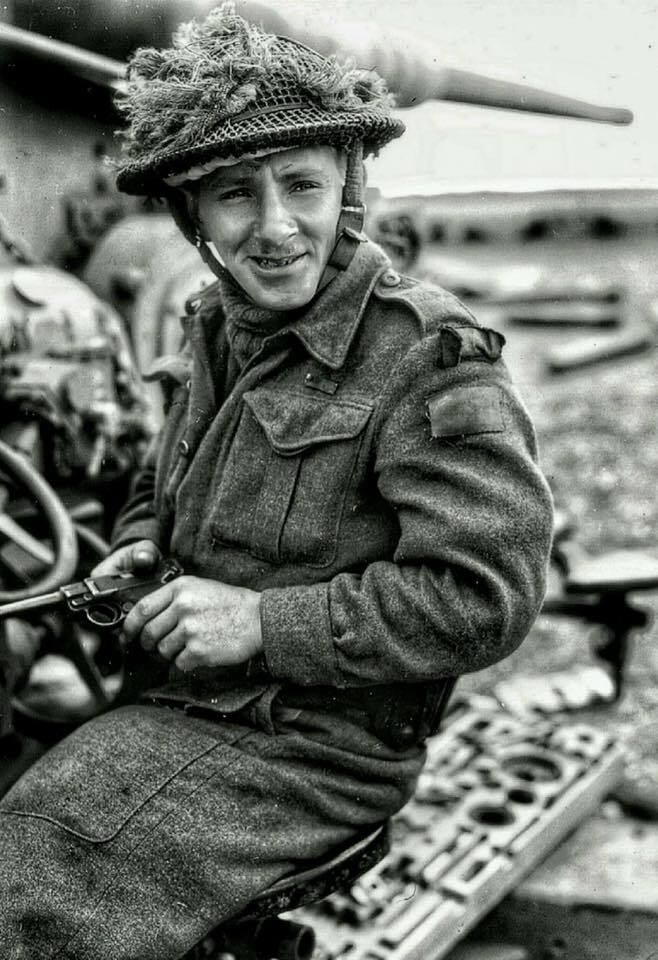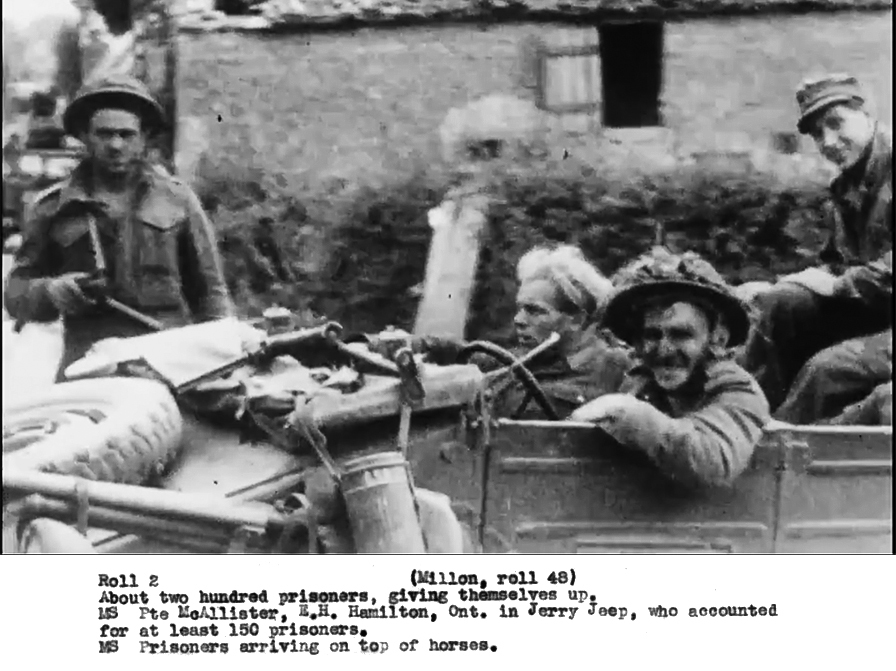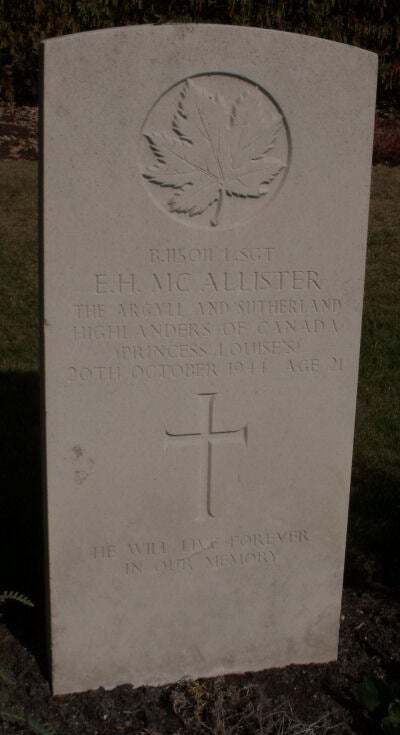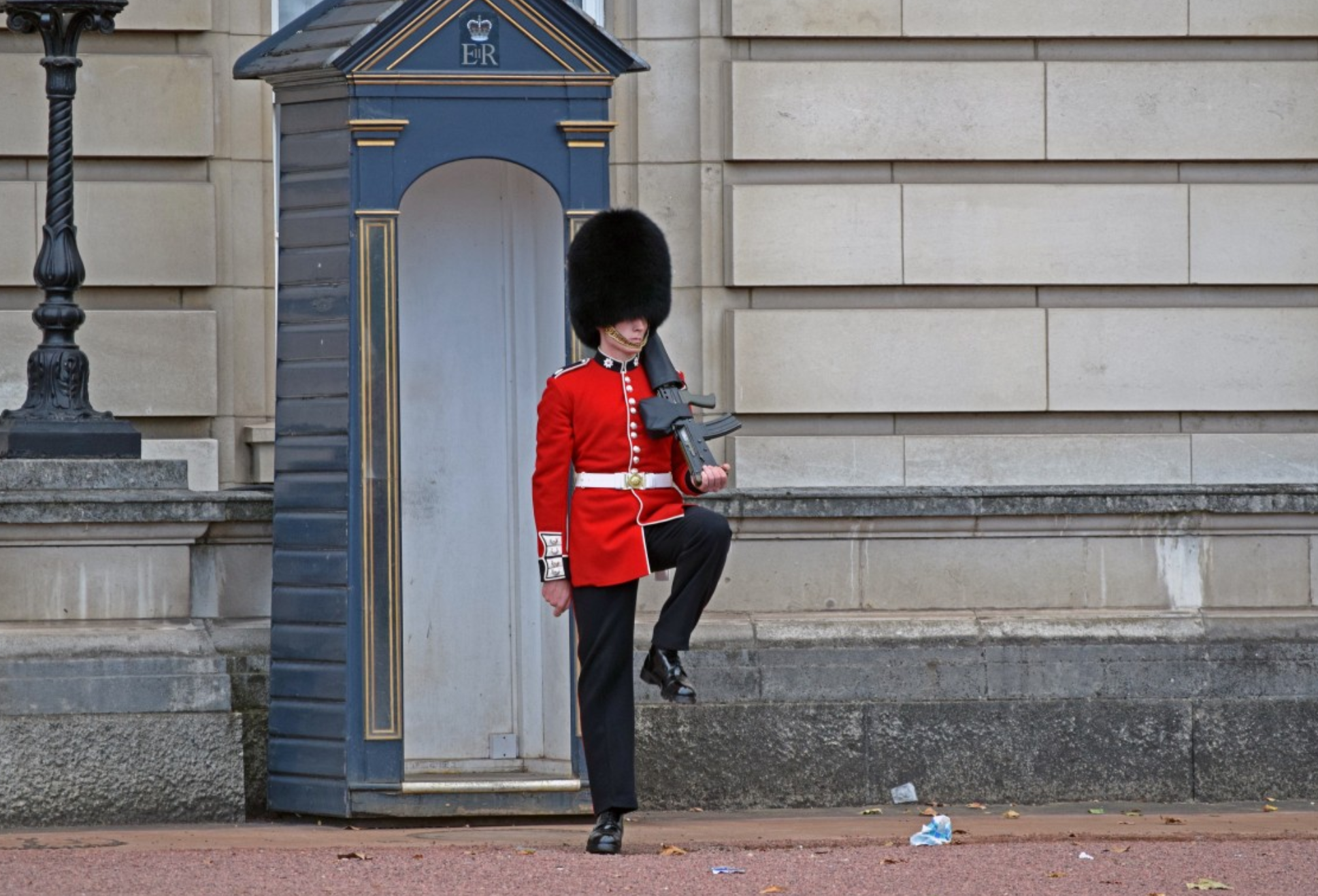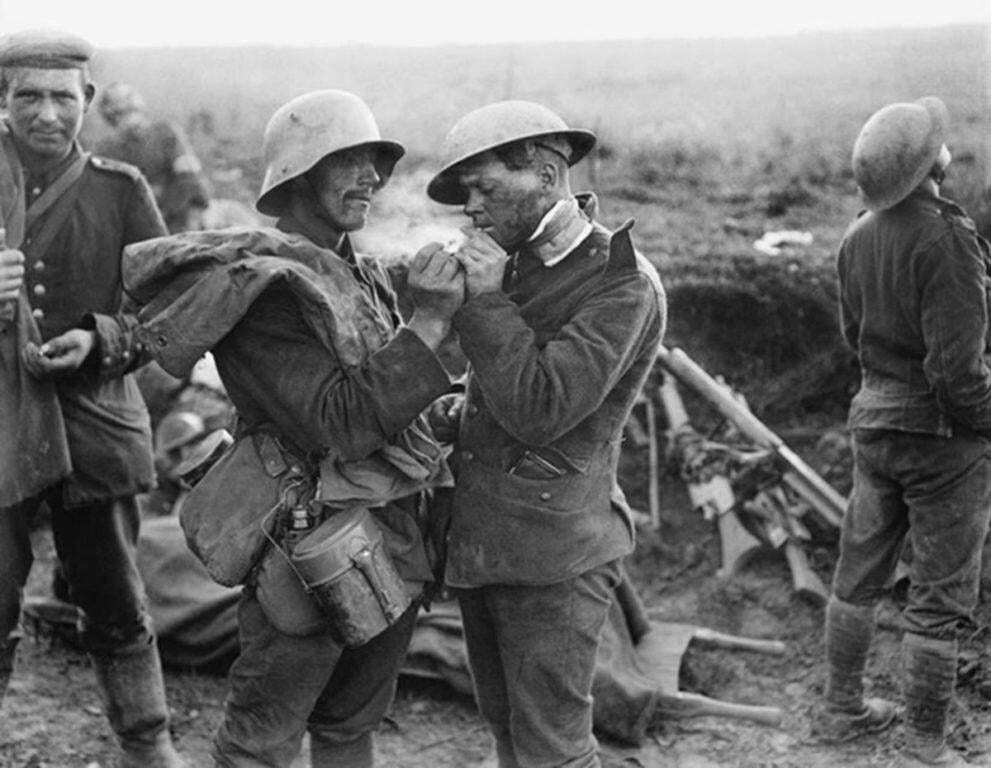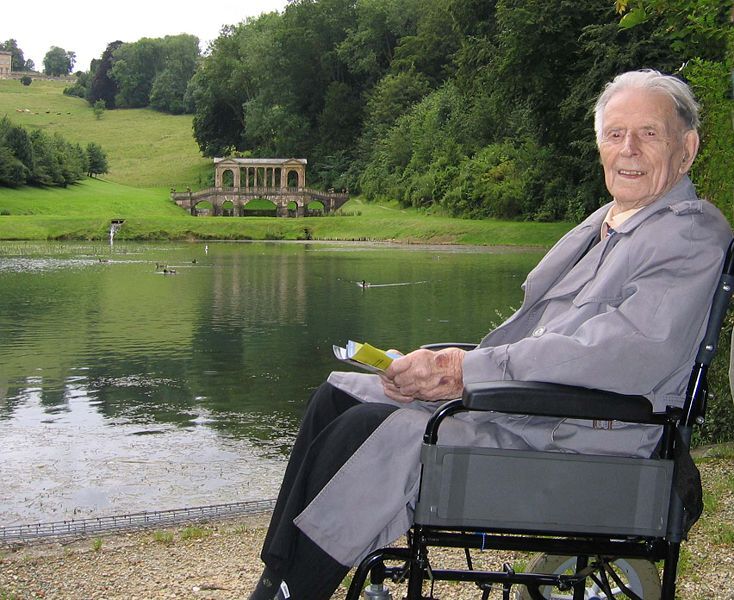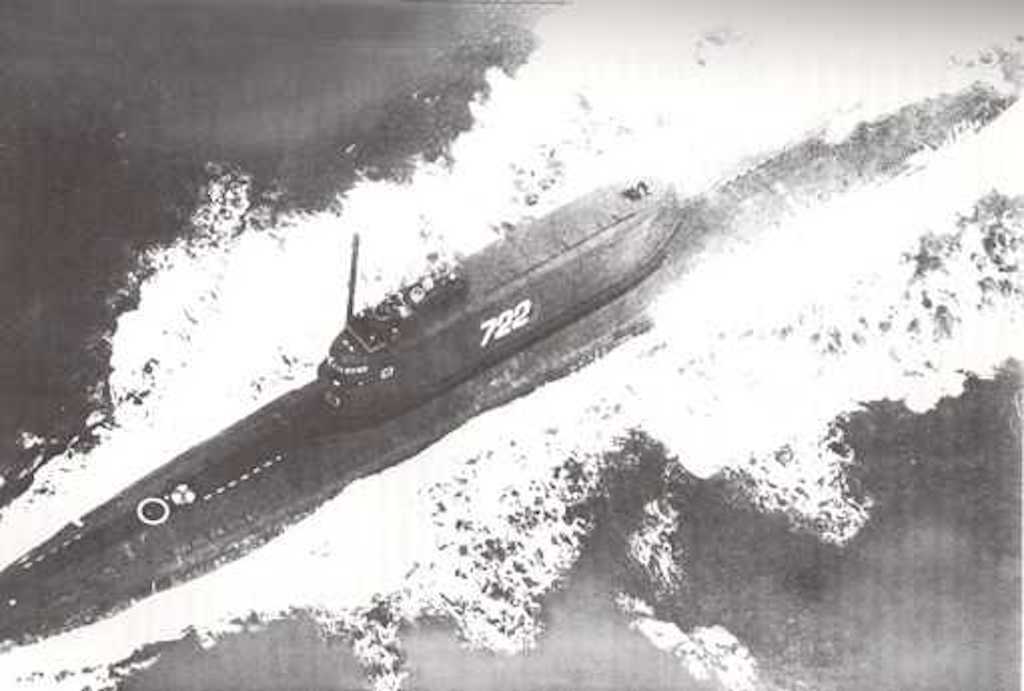- Posts: 1270
- Thank you received: 1797
Little stories
- Maki
-

- Offline
Less
More
3 years 11 months ago #85
by Maki
Replied by Maki on topic Little stories
Why this World War II British fighter was painted pink
Pink Spitfire MK XI PR.The part of the day wIth the sun setting or rising in the hours after a bombing raid can be a dangerous time for the enemy who just bombed a city to make reconnaissance flights over their targets. Still, it was necessary to asses the damage caused by the bombing run. The high alert and likely strong feelings on the ground in the wake of a bombing mission meant a tough time for the pilot of the recon plane. Such a mission required the pilot to be given every opportunity not only to succeed in taking the necessary photos, but also to survive the mission and make their way back home to Britain. One of the ways of accomplishing this feat was proper camouflage. Given the time of day, that meant painting their vaunted fighter a most unlikely color.
The British-made Supermarine Spitfire is best remembered for its tactical success during the Battle of Britain. Its top speed and powerful engine made it more than a match for Nazi Germany’s Luftwaffe fighters and bombers. Its fights with the German Messerschmitt Bf-109 were so legendary, people believed the Spitfire was England’s primary fighter aircraft (it wasn’t), and that it was the best performer in the Royal Air Force at the time (it was).
Despite its excellent combat performance, not all Supermarine Spitfires were made for downing Nazi airplanes. Some of them were built to take photos, specifically photos of the aftermath of Allied bombing missions. To do this required a lot of intrepidity and more than a few options for the fighter pilot when coming under fire. Photo reconnaissance was one of the most important and most dangerous missions in all of World War II. Spitfires converted for the role were the best fighters for the job, and were so good that even the United States used them for photo reconnaissance and bomb damage assessments.
Supermarine Spitfires were not only fast and maneuverable fighter aircraft, when specially converted to remove its weapons and they were replaced with fuel tanks, it gave the plane exceptional range to boot. They were able to fly all over occupied Europe to determine the status of the RAF’s and U.S. Army Air Forces’ bombing missions. Its range when converted this way extended all the way to the far end of the Baltic Sea
Without weapons, though, Spitfires could be sitting ducks for interceptor aircraft and for anti-aircraft fire coming from ground-based guns. While moving and taking photos was a simple enough job, being defenseless over enemy territory meant pilots needed every advantage available to them. To give them a leg up over anti-aircraft guns and flak, the planes were designed to blend in with their surroundings while completing its mission.
This meant the aircraft was painted pink, so it could blend in with the sky as specific times of day, namely sunrise and sunset. Throughout the war, the Spitfire completed its intense mission and a total of more than a thousand Spitfires were converted into photo recon planes, painted pink, and sent to determine which cities would need another bombing run based on target destruction. Pink Spitfires led that effort, blending in with the evening and morning suns to determine the effectiveness of a bombing mission.Their distinctive color camouflage allowed them to blend in with the skies, making these recon missions far less deadly than they could have been.
Pink Spitfire MK XI PR.The part of the day wIth the sun setting or rising in the hours after a bombing raid can be a dangerous time for the enemy who just bombed a city to make reconnaissance flights over their targets. Still, it was necessary to asses the damage caused by the bombing run. The high alert and likely strong feelings on the ground in the wake of a bombing mission meant a tough time for the pilot of the recon plane. Such a mission required the pilot to be given every opportunity not only to succeed in taking the necessary photos, but also to survive the mission and make their way back home to Britain. One of the ways of accomplishing this feat was proper camouflage. Given the time of day, that meant painting their vaunted fighter a most unlikely color.
The British-made Supermarine Spitfire is best remembered for its tactical success during the Battle of Britain. Its top speed and powerful engine made it more than a match for Nazi Germany’s Luftwaffe fighters and bombers. Its fights with the German Messerschmitt Bf-109 were so legendary, people believed the Spitfire was England’s primary fighter aircraft (it wasn’t), and that it was the best performer in the Royal Air Force at the time (it was).
Despite its excellent combat performance, not all Supermarine Spitfires were made for downing Nazi airplanes. Some of them were built to take photos, specifically photos of the aftermath of Allied bombing missions. To do this required a lot of intrepidity and more than a few options for the fighter pilot when coming under fire. Photo reconnaissance was one of the most important and most dangerous missions in all of World War II. Spitfires converted for the role were the best fighters for the job, and were so good that even the United States used them for photo reconnaissance and bomb damage assessments.
Supermarine Spitfires were not only fast and maneuverable fighter aircraft, when specially converted to remove its weapons and they were replaced with fuel tanks, it gave the plane exceptional range to boot. They were able to fly all over occupied Europe to determine the status of the RAF’s and U.S. Army Air Forces’ bombing missions. Its range when converted this way extended all the way to the far end of the Baltic Sea
Without weapons, though, Spitfires could be sitting ducks for interceptor aircraft and for anti-aircraft fire coming from ground-based guns. While moving and taking photos was a simple enough job, being defenseless over enemy territory meant pilots needed every advantage available to them. To give them a leg up over anti-aircraft guns and flak, the planes were designed to blend in with their surroundings while completing its mission.
This meant the aircraft was painted pink, so it could blend in with the sky as specific times of day, namely sunrise and sunset. Throughout the war, the Spitfire completed its intense mission and a total of more than a thousand Spitfires were converted into photo recon planes, painted pink, and sent to determine which cities would need another bombing run based on target destruction. Pink Spitfires led that effort, blending in with the evening and morning suns to determine the effectiveness of a bombing mission.Their distinctive color camouflage allowed them to blend in with the skies, making these recon missions far less deadly than they could have been.
The following user(s) said Thank You: snowman, Juanma66
Please Log in or Create an account to join the conversation.
- snowman
-

- Offline
- Your most dear friend.
3 years 10 months ago #86
by snowman
Love this photo and this article. Thank you, Maki
"Straight and narrow is the path."
Replied by snowman on topic Little stories
Only real men can fly vulnerable pink fighter planesWhy this World War II British fighter was painted pink
Love this photo and this article. Thank you, Maki
"Straight and narrow is the path."
Please Log in or Create an account to join the conversation.
- Maki
-

- Offline
Less
More
- Posts: 1270
- Thank you received: 1797
3 years 10 months ago #87
by Maki
Replied by Maki on topic Little stories
How a single Canadian soldier captured 160 Nazis in one day
Fortune favors the bold, especially on the battlefield. One of the boldest was Earl Henry McAllister of Hamilton, Ontario, who went by the nicknames “Mac” or “Scotty.” On September 11, 1942, McAllister enlisted in the Royal Canadian Air Force. However, he was washed out after a weak nerve was discovered in his ear. Undeterred, McAllister joined the infantry and was assigned to Princess Louise’s Argyle and Sutherland Highlanders of Canada.
McAllister’s Highlander photograph (Veterans Affairs Canada)
McAllister was just 19 years old when he enlisted. At 5’3″ and weighing 135 pounds, his sister, Joyce, recalled that the Highlanders had trouble finding a uniform that would fit him. “He got the shortest kilt he could find. He pulled it up under his armpits and put a belt on to hold it up and then put his jacket on,” she told The Hamilton Spectator. “He was so proud of that uniform.”
Despite his stature, McAllister was a capable athlete and showed great intellect and potential as a soldier. His personnel record noted that after just 6 months with the Highlanders, he was recommended for an NCO course.
McAllister’s personal drive could be seen in his determination to serve his country well. Before he left for the war in Europe, he told his parents, “Either I come back a hero or I won’t come back at all.” By February 1944, McAllister and the Highlanders’ 2nd Battalion were overseas preparing for the invasion of Normandy.
McAllister poses with two captured German guns: a 9mm Luger and a 105mm anti-tank gun (Veterans Affairs Canada)Although McAllister was not part of the initial beach landings on D-Day, he joined the fighting shortly after. One morning, Pvt. McAllister was driving a couple of German POWs back to a British camp in a captured Wehrmacht car when he was ambushed by more Germans. McAllister sprang into action and charged the enemy. After a brief exchange of fire, the lone Canadian took the Germans prisoner.Continuing back to camp with his now slightly larger group of POWs, McAllister came across a French fighter who informed him of a group of Germans hiding in the woods nearby. With great confidence, McAllister instructed his 5 prisoners to continue walking toward the camp unguarded. Incredibly, they followed his instructions and turned themselves over to British soldiers.After sending his prisoners on their way, McAllister drove the captured German car down a woodland road until he received artillery fire. Canadian guns, mistaking him for a German, forced McAllister to ditch the German car and continue into the woods on foot. When he located the hidden Germans, McAllister fired over their heads and demanded their surrender. After throwing down their weapons, McAllister instructed the Germans walk to the British camp unguarded. Like the prisoners before them, the 25 Germans obeyed.
Wary that there could be more enemy soldiers hiding in the woods, McAllister continued his search and came across 60 more Germans. Again, he fired over their heads, accepted their surrender, and sent them on their way to the camp unguarded.McAllister was again approached by a French fighter who informed him of a large group of Germans with a Tiger tank nearby. However, upon scouting the position, McAllister discovered that reported Tiger was actually just an armored car. Seeing no need to gather reinforcements, McAllister commandeered the armored car and demanded the surrender of another 70 Germans; they obeyed. With great strength, confidence, and courage, McAllister captured 160 Germans in a single day.Word of McAllister’s exploits spread like wildfire. He was the subject of a news reel that depicted him on a captured German 105mm anti-tank gun while holding a Luger pistol as well as Germans captured by him marching. There was even a comic printed about him called “Scotty Sent Us.” The comic’s title refers to reports that at least one of the groups of German POWs reported to the British camp saying, “Scotty sent us.”
McAllister’s grave marker in the Netherlands (Veterans Affairs Canada)
With part of his prophecy fulfilled, McAllister was a bona fide war hero. However, he was not entirely correct in his pre-deployment prediction. Although McAllister survived the Normandy campaign, he was later killed in Belgium on October 20. Rapidly promoted after his success in Normandy, Lance-Sergeant McAllister was attempting to rescue one of his wounded soldiers when he himself was shot and killed. He was buried in a temporary grave in Belgium and now rests at the Bergen-op-Zoom Canadian War Cemetery in the Netherlands.
Fortune favors the bold, especially on the battlefield. One of the boldest was Earl Henry McAllister of Hamilton, Ontario, who went by the nicknames “Mac” or “Scotty.” On September 11, 1942, McAllister enlisted in the Royal Canadian Air Force. However, he was washed out after a weak nerve was discovered in his ear. Undeterred, McAllister joined the infantry and was assigned to Princess Louise’s Argyle and Sutherland Highlanders of Canada.
McAllister’s Highlander photograph (Veterans Affairs Canada)
McAllister was just 19 years old when he enlisted. At 5’3″ and weighing 135 pounds, his sister, Joyce, recalled that the Highlanders had trouble finding a uniform that would fit him. “He got the shortest kilt he could find. He pulled it up under his armpits and put a belt on to hold it up and then put his jacket on,” she told The Hamilton Spectator. “He was so proud of that uniform.”
Despite his stature, McAllister was a capable athlete and showed great intellect and potential as a soldier. His personnel record noted that after just 6 months with the Highlanders, he was recommended for an NCO course.
McAllister’s personal drive could be seen in his determination to serve his country well. Before he left for the war in Europe, he told his parents, “Either I come back a hero or I won’t come back at all.” By February 1944, McAllister and the Highlanders’ 2nd Battalion were overseas preparing for the invasion of Normandy.
McAllister poses with two captured German guns: a 9mm Luger and a 105mm anti-tank gun (Veterans Affairs Canada)Although McAllister was not part of the initial beach landings on D-Day, he joined the fighting shortly after. One morning, Pvt. McAllister was driving a couple of German POWs back to a British camp in a captured Wehrmacht car when he was ambushed by more Germans. McAllister sprang into action and charged the enemy. After a brief exchange of fire, the lone Canadian took the Germans prisoner.Continuing back to camp with his now slightly larger group of POWs, McAllister came across a French fighter who informed him of a group of Germans hiding in the woods nearby. With great confidence, McAllister instructed his 5 prisoners to continue walking toward the camp unguarded. Incredibly, they followed his instructions and turned themselves over to British soldiers.After sending his prisoners on their way, McAllister drove the captured German car down a woodland road until he received artillery fire. Canadian guns, mistaking him for a German, forced McAllister to ditch the German car and continue into the woods on foot. When he located the hidden Germans, McAllister fired over their heads and demanded their surrender. After throwing down their weapons, McAllister instructed the Germans walk to the British camp unguarded. Like the prisoners before them, the 25 Germans obeyed.
Wary that there could be more enemy soldiers hiding in the woods, McAllister continued his search and came across 60 more Germans. Again, he fired over their heads, accepted their surrender, and sent them on their way to the camp unguarded.McAllister was again approached by a French fighter who informed him of a large group of Germans with a Tiger tank nearby. However, upon scouting the position, McAllister discovered that reported Tiger was actually just an armored car. Seeing no need to gather reinforcements, McAllister commandeered the armored car and demanded the surrender of another 70 Germans; they obeyed. With great strength, confidence, and courage, McAllister captured 160 Germans in a single day.Word of McAllister’s exploits spread like wildfire. He was the subject of a news reel that depicted him on a captured German 105mm anti-tank gun while holding a Luger pistol as well as Germans captured by him marching. There was even a comic printed about him called “Scotty Sent Us.” The comic’s title refers to reports that at least one of the groups of German POWs reported to the British camp saying, “Scotty sent us.”
McAllister’s grave marker in the Netherlands (Veterans Affairs Canada)
With part of his prophecy fulfilled, McAllister was a bona fide war hero. However, he was not entirely correct in his pre-deployment prediction. Although McAllister survived the Normandy campaign, he was later killed in Belgium on October 20. Rapidly promoted after his success in Normandy, Lance-Sergeant McAllister was attempting to rescue one of his wounded soldiers when he himself was shot and killed. He was buried in a temporary grave in Belgium and now rests at the Bergen-op-Zoom Canadian War Cemetery in the Netherlands.
The following user(s) said Thank You: snowman, Nikita
Please Log in or Create an account to join the conversation.
- snowman
-

- Offline
- Your most dear friend.
3 years 10 months ago #88
by snowman
"Straight and narrow is the path."
Replied by snowman on topic Little stories
"Straight and narrow is the path."
The following user(s) said Thank You: Maki
Please Log in or Create an account to join the conversation.
- Maki
-

- Offline
Less
More
- Posts: 1270
- Thank you received: 1797
3 years 9 months ago #89
by Maki
Replied by Maki on topic Little stories
This is how British troops got the nickname ‘Tommies’
In the trenches of World War I, German and French troops would call out over the trenches looking for “Tommy” when they wanted to talk to a British soldier. You don’t hear the term quite so much anymore, but for centuries, Tommies reigned supreme.
How exactly British troops came to be called Tommy is not quite as complex as why German troops were known as “Jerry” (in case you were wondering, it’s believed to be either because “Jerry” is short for German, or because their helmets looked like a chamber pots).
Jerry offers Tommy a light in this undated photo .Britain’s Imperial War Museum says the origin of the literal nom de guerre is disputed. One theory says it originated with the Duke of Wellington who made it the nickname in 1843. Another says the Imperial War Office established it in 1845 — a sort of British “John Doe.”But the Imperial War Museum found evidence of “Tommy” more than a century before Wellington supposedly coined it.During the British rule of Jamaica, researchers found a 1743 letter to the war office that reported a mutiny among mercenaries there, saying “Except for those from N. America, ye Marines and Tommy Atkins behaved splendidly.”It was also at this time the red coats worn by British regulars earned them the nickname “Thomas Lobster.”
Because camouflage is for wimps.By 1815, the British War Office was using the name “Tommy Atkins” as a generic term – a placeholder name – for sample infantry paperwork. An enlisting soldier unable to sign his name to his enlistment papers would make his mark – leaving the name Tommy Atkins spelled out where his real name should have been.“Tommy Atkins” and everyone known to history as Tommy Atkins had a distinguished career in the British military. During the Sepoy Rebellion in India in 1857, a soldier of the 32d Regiment of Foot remained at his post when most others already fled. He was, of course, overwhelmed and killed. A witness of his heroism later wrote:
“His name happened to be Tommy Atkins and so, throughout the Mutiny Campaign, when a daring deed was done, the doer was said to be ‘a regular Tommy Atkins.’ “Other Thomas Atkins (or a variation thereof) also appeared as a Royal Welch Fusilier in the American Revolution, the poems of Rudyard Kipling, and indeed with the Duke of Wellington in the 33rd Regiment of Foot at the Battle of Boxtel in 1794.The last Tommy – Harry Patch of the World War I-era British Army – died in 2009, at the ripe old age of 111. Harry Patch in 2009
In the trenches of World War I, German and French troops would call out over the trenches looking for “Tommy” when they wanted to talk to a British soldier. You don’t hear the term quite so much anymore, but for centuries, Tommies reigned supreme.
How exactly British troops came to be called Tommy is not quite as complex as why German troops were known as “Jerry” (in case you were wondering, it’s believed to be either because “Jerry” is short for German, or because their helmets looked like a chamber pots).
Jerry offers Tommy a light in this undated photo .Britain’s Imperial War Museum says the origin of the literal nom de guerre is disputed. One theory says it originated with the Duke of Wellington who made it the nickname in 1843. Another says the Imperial War Office established it in 1845 — a sort of British “John Doe.”But the Imperial War Museum found evidence of “Tommy” more than a century before Wellington supposedly coined it.During the British rule of Jamaica, researchers found a 1743 letter to the war office that reported a mutiny among mercenaries there, saying “Except for those from N. America, ye Marines and Tommy Atkins behaved splendidly.”It was also at this time the red coats worn by British regulars earned them the nickname “Thomas Lobster.”
Because camouflage is for wimps.By 1815, the British War Office was using the name “Tommy Atkins” as a generic term – a placeholder name – for sample infantry paperwork. An enlisting soldier unable to sign his name to his enlistment papers would make his mark – leaving the name Tommy Atkins spelled out where his real name should have been.“Tommy Atkins” and everyone known to history as Tommy Atkins had a distinguished career in the British military. During the Sepoy Rebellion in India in 1857, a soldier of the 32d Regiment of Foot remained at his post when most others already fled. He was, of course, overwhelmed and killed. A witness of his heroism later wrote:
“His name happened to be Tommy Atkins and so, throughout the Mutiny Campaign, when a daring deed was done, the doer was said to be ‘a regular Tommy Atkins.’ “Other Thomas Atkins (or a variation thereof) also appeared as a Royal Welch Fusilier in the American Revolution, the poems of Rudyard Kipling, and indeed with the Duke of Wellington in the 33rd Regiment of Foot at the Battle of Boxtel in 1794.The last Tommy – Harry Patch of the World War I-era British Army – died in 2009, at the ripe old age of 111. Harry Patch in 2009
The following user(s) said Thank You: snowman, Juanma66
Please Log in or Create an account to join the conversation.
- Maki
-

- Offline
Less
More
- Posts: 1270
- Thank you received: 1797
3 years 9 months ago #90
by Maki
Replied by Maki on topic Little stories
A rogue Soviet submarine might have been destroyed trying to start World War III
Golf II-class ballistic missile submarine K-129, hull number 722. In March 1968, one of the Soviet Union’s most powerful vessels, a diesel-electric ballistic missile submarine carrying one megaton nuclear weapons, suddenly sank in the Pacific Ocean. K-129 was on a combat patrol, ready to respond to any American first strike, when it failed to check in with Moscow. When the submarine was finally found on the ocean floor, it was nowhere near its intended patrol route. Instead, K-129 was found just northwest of the Hawaiian island of Oahu. What the Soviet submarine was doing there and why has been a subject of debate since it was found. Many believe the crew had been taken over by KGB operatives and was on its way to start World War III with the United States. Like American ballistic missile submarines, the Soviet Union’s submarine force would disappear below the waves, conducting their missions in secret and standing ready to respond to aggression from the other superpower. In fact, it was standard policy for U.S. Navy submarines to tail Soviet subs as they left bases on the Pacific Ocean.
629A submarine profile.
In February 1968, K-129 set out from its home port in Kamchatka and dove into deep water. It was the vessel’s third combat patrol in two years, and was expected to be uneventful. By mid-March, the ship had missed two consecutive planned check-ins with Soviet naval authorities. The USSR began to grow concerned and launched an all-out effort to find K-129, using air, surface, and underwater rescue assets. When the Soviets mobilized with such a force, the Americans were likely to notice – and they did. The immediately recognized a potential submarine loss and kept a watchful eye on the Soviets. In the meantime, the U.S. began a search effort of its own, and it’s a good thing they did. The USSR declared the boat lost, but the Americans and their superior technology located the wreck of K-129. President Richard Nixon authorized the CIA and billionaire Howard Hughes to launch a historic effort to raise K-129 from a depth of 16,000 feet. Their cover was manganese mining exploration, but the Soviets weren’t fooled. The U.S. has never completely divulged what it pulled up, but it was enough to make conspiracy theorists go wild. Using the facts available from the USSR and looking at the geopolitical situation at the time, many believe the USSR was trying to start a war – between the United States and China.
The recovery site of К-129 based on the intersection of three circles marking the distances to Long Beach, CA, Pearl Harbor, HI, and Petropavlovsk, Kamchatka.
There are three important factors that led to this theory. The first and foremost is the question of why K-129 was found where it was. According to both Soviet and American officials, K-129 was found in a place it definitely did not belong. The second factor is the existence of 11 extra crew members on the ship’s official complement. Many of the K-129 sailors were new, but the complement never describes the roles of the extra men aboard. Finally, there’s the question of what happened to the sub.One of the possible reasons for the loss of K-129 was an explosion from inside the vessel. The theory says that K-129 was taken over by the 11 extra men, who were actually KGB operatives. They forced the boat’s skipper to sail in an area he knew he should not be, but he obliged, unsure of their goal. As for what happened to sink the sub, when the KGB ordered him to fire his ballistic missiles, the theory says, he initiated a failsafe sequence that appeared to be a launch but instead destroyed the missile launchers and thus the submarine, killing everyone aboard. Their position in the Pacific Ocean would make it appear as if the missiles had come from China.If the theory is true, then one Soviet captain prevented a possible World War III. President Nixon would soon open relations between China and the U.S., making such a provocation unlikely and ending any Soviet effort to start a war between the two powers.
Golf II-class ballistic missile submarine K-129, hull number 722. In March 1968, one of the Soviet Union’s most powerful vessels, a diesel-electric ballistic missile submarine carrying one megaton nuclear weapons, suddenly sank in the Pacific Ocean. K-129 was on a combat patrol, ready to respond to any American first strike, when it failed to check in with Moscow. When the submarine was finally found on the ocean floor, it was nowhere near its intended patrol route. Instead, K-129 was found just northwest of the Hawaiian island of Oahu. What the Soviet submarine was doing there and why has been a subject of debate since it was found. Many believe the crew had been taken over by KGB operatives and was on its way to start World War III with the United States. Like American ballistic missile submarines, the Soviet Union’s submarine force would disappear below the waves, conducting their missions in secret and standing ready to respond to aggression from the other superpower. In fact, it was standard policy for U.S. Navy submarines to tail Soviet subs as they left bases on the Pacific Ocean.
629A submarine profile.
In February 1968, K-129 set out from its home port in Kamchatka and dove into deep water. It was the vessel’s third combat patrol in two years, and was expected to be uneventful. By mid-March, the ship had missed two consecutive planned check-ins with Soviet naval authorities. The USSR began to grow concerned and launched an all-out effort to find K-129, using air, surface, and underwater rescue assets. When the Soviets mobilized with such a force, the Americans were likely to notice – and they did. The immediately recognized a potential submarine loss and kept a watchful eye on the Soviets. In the meantime, the U.S. began a search effort of its own, and it’s a good thing they did. The USSR declared the boat lost, but the Americans and their superior technology located the wreck of K-129. President Richard Nixon authorized the CIA and billionaire Howard Hughes to launch a historic effort to raise K-129 from a depth of 16,000 feet. Their cover was manganese mining exploration, but the Soviets weren’t fooled. The U.S. has never completely divulged what it pulled up, but it was enough to make conspiracy theorists go wild. Using the facts available from the USSR and looking at the geopolitical situation at the time, many believe the USSR was trying to start a war – between the United States and China.
The recovery site of К-129 based on the intersection of three circles marking the distances to Long Beach, CA, Pearl Harbor, HI, and Petropavlovsk, Kamchatka.
There are three important factors that led to this theory. The first and foremost is the question of why K-129 was found where it was. According to both Soviet and American officials, K-129 was found in a place it definitely did not belong. The second factor is the existence of 11 extra crew members on the ship’s official complement. Many of the K-129 sailors were new, but the complement never describes the roles of the extra men aboard. Finally, there’s the question of what happened to the sub.One of the possible reasons for the loss of K-129 was an explosion from inside the vessel. The theory says that K-129 was taken over by the 11 extra men, who were actually KGB operatives. They forced the boat’s skipper to sail in an area he knew he should not be, but he obliged, unsure of their goal. As for what happened to sink the sub, when the KGB ordered him to fire his ballistic missiles, the theory says, he initiated a failsafe sequence that appeared to be a launch but instead destroyed the missile launchers and thus the submarine, killing everyone aboard. Their position in the Pacific Ocean would make it appear as if the missiles had come from China.If the theory is true, then one Soviet captain prevented a possible World War III. President Nixon would soon open relations between China and the U.S., making such a provocation unlikely and ending any Soviet effort to start a war between the two powers.
The following user(s) said Thank You: snowman, Juanma66
Please Log in or Create an account to join the conversation.
Birthdays
- Tecnom in 1 day
- Hellcat in 4 days
- Winters in 5 days
- Alexliberty in 6 days
- Mizha in 10 days



